Leading Change: Impact on Strategy and Operations at Unilever
VerifiedAdded on 2022/12/30
|17
|4581
|86
Report
AI Summary
This report analyzes Unilever's approach to leading and managing change within its organizational structure. It begins by examining how changes impact an organization's strategy and operations, using Unilever as a case study, and highlights examples such as environmental initiatives and product adjustments. The report then delves into the internal and external drivers of change, including employee and leadership behaviors, along with technological, economic, and political factors, as revealed through a SWOT and PESTLE analysis. It also covers measures to minimize the negative impacts of change, like clear communication and employee training. Furthermore, the report addresses barriers to change, such as individual resistance and lack of communication, and their influence on leadership decision-making. Finally, it explores various leadership approaches for dealing with change, offering insights into how Unilever navigates these challenges.
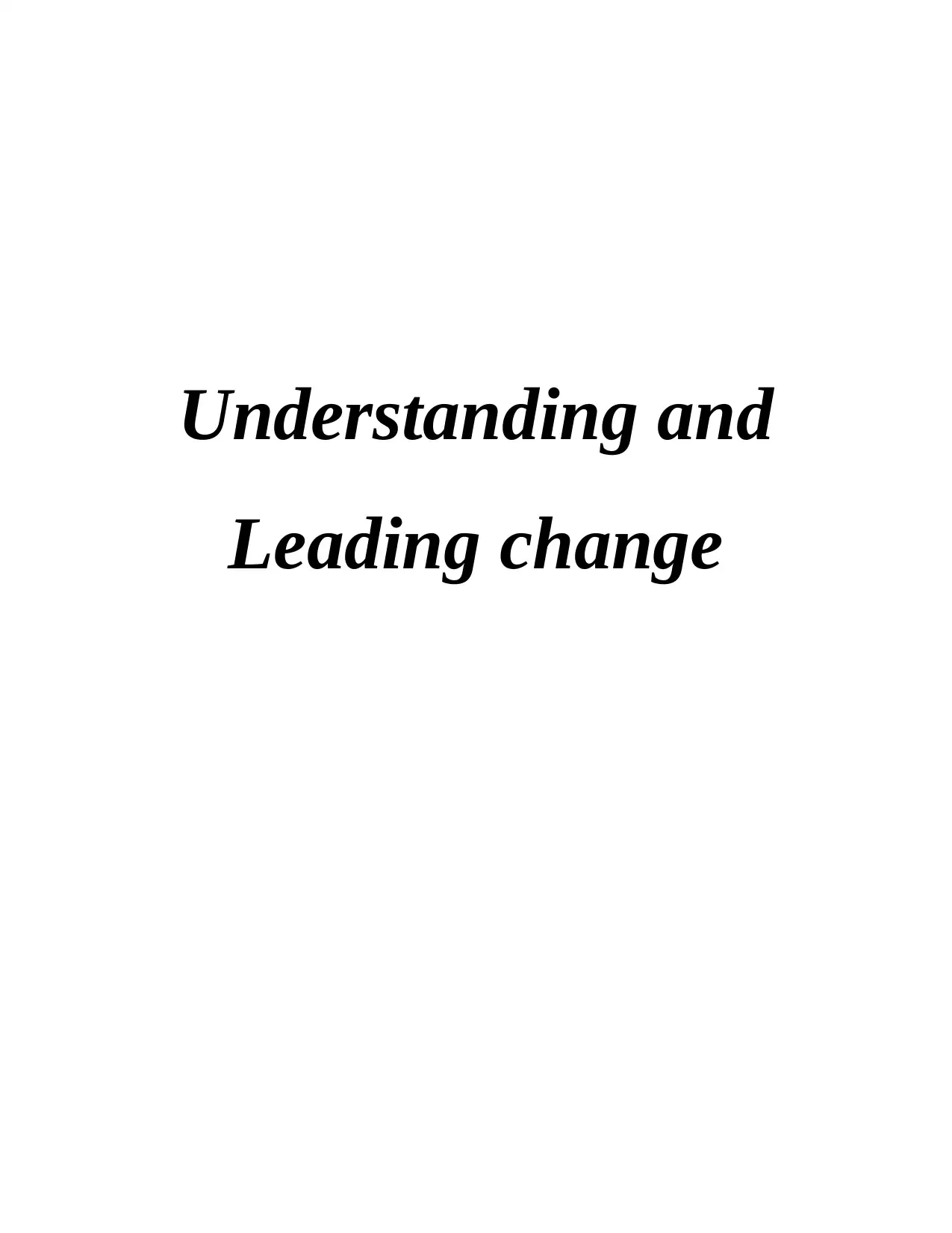
Understanding and
Leading change
Leading change
Paraphrase This Document
Need a fresh take? Get an instant paraphrase of this document with our AI Paraphraser
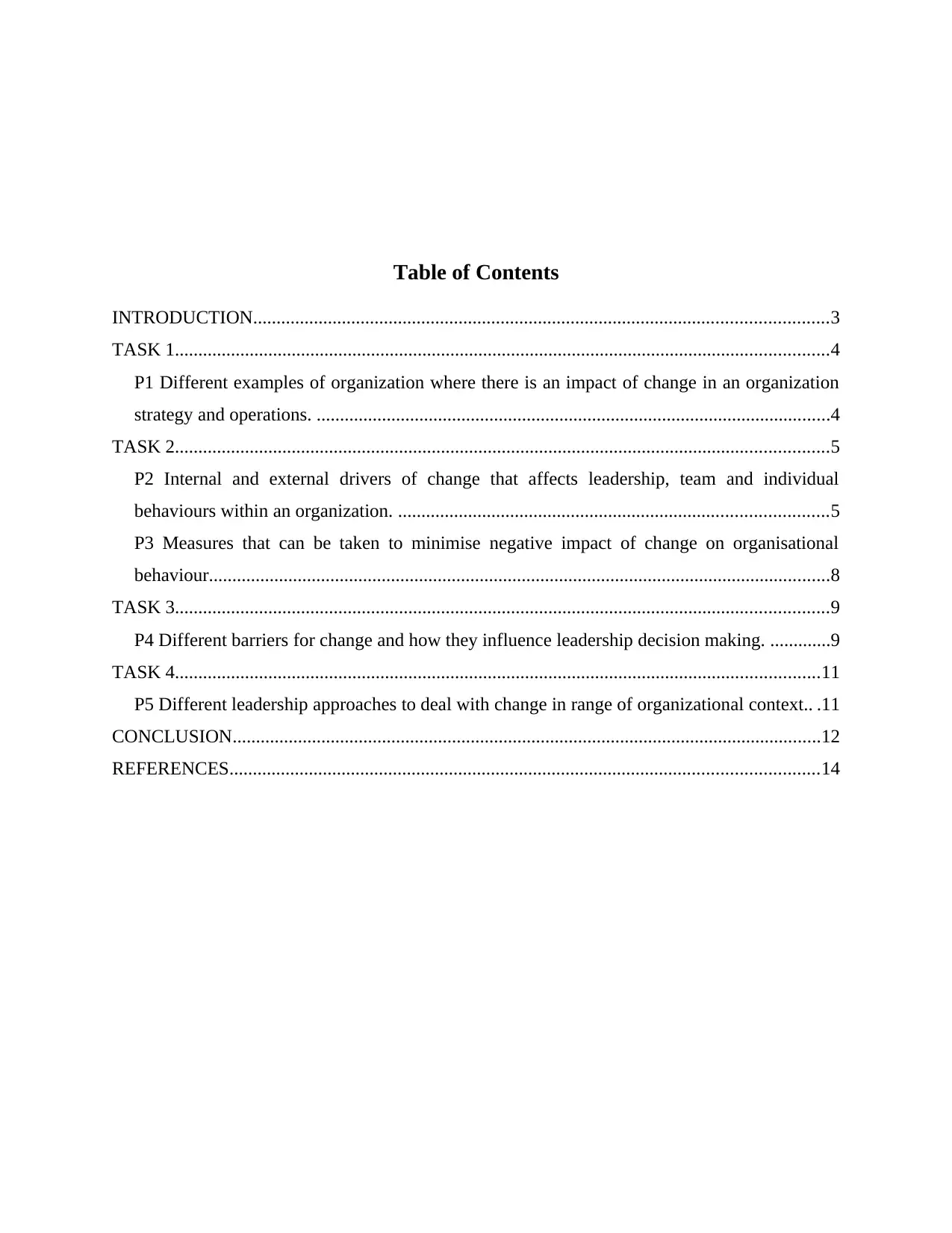
Table of Contents
INTRODUCTION...........................................................................................................................3
TASK 1............................................................................................................................................4
P1 Different examples of organization where there is an impact of change in an organization
strategy and operations. ..............................................................................................................4
TASK 2............................................................................................................................................5
P2 Internal and external drivers of change that affects leadership, team and individual
behaviours within an organization. ............................................................................................5
P3 Measures that can be taken to minimise negative impact of change on organisational
behaviour.....................................................................................................................................8
TASK 3............................................................................................................................................9
P4 Different barriers for change and how they influence leadership decision making. .............9
TASK 4..........................................................................................................................................11
P5 Different leadership approaches to deal with change in range of organizational context.. .11
CONCLUSION..............................................................................................................................12
REFERENCES..............................................................................................................................14
INTRODUCTION...........................................................................................................................3
TASK 1............................................................................................................................................4
P1 Different examples of organization where there is an impact of change in an organization
strategy and operations. ..............................................................................................................4
TASK 2............................................................................................................................................5
P2 Internal and external drivers of change that affects leadership, team and individual
behaviours within an organization. ............................................................................................5
P3 Measures that can be taken to minimise negative impact of change on organisational
behaviour.....................................................................................................................................8
TASK 3............................................................................................................................................9
P4 Different barriers for change and how they influence leadership decision making. .............9
TASK 4..........................................................................................................................................11
P5 Different leadership approaches to deal with change in range of organizational context.. .11
CONCLUSION..............................................................................................................................12
REFERENCES..............................................................................................................................14
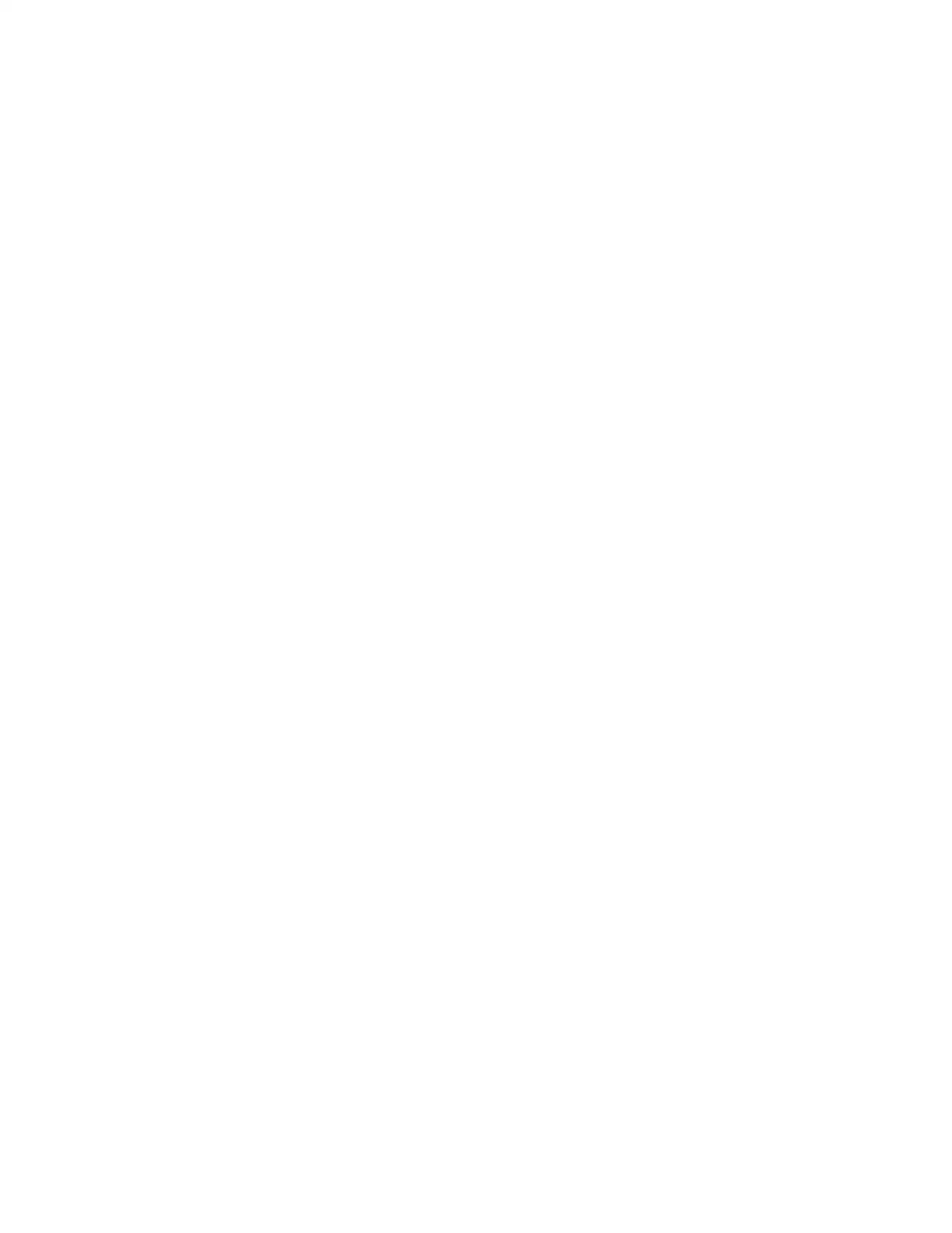
⊘ This is a preview!⊘
Do you want full access?
Subscribe today to unlock all pages.

Trusted by 1+ million students worldwide
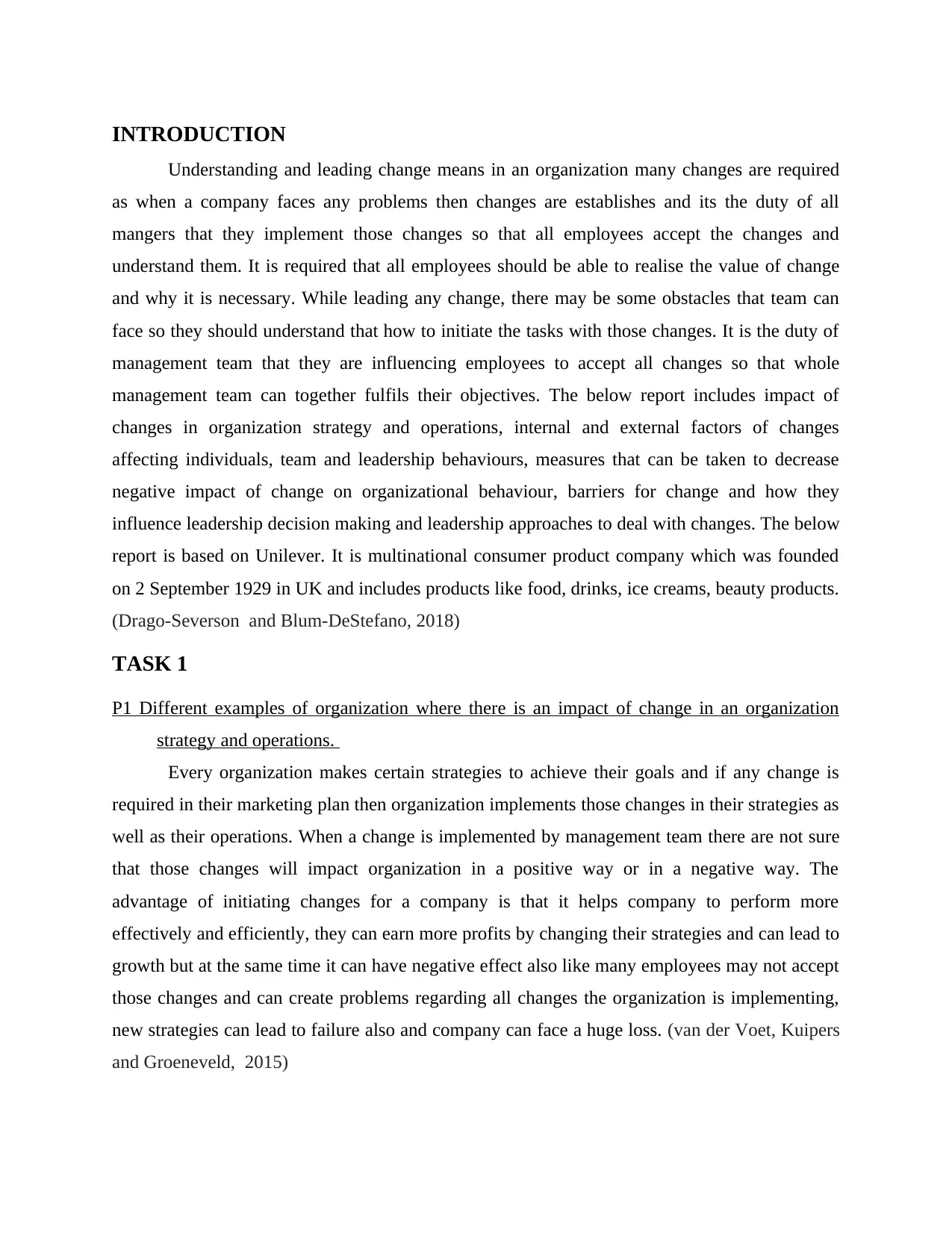
INTRODUCTION
Understanding and leading change means in an organization many changes are required
as when a company faces any problems then changes are establishes and its the duty of all
mangers that they implement those changes so that all employees accept the changes and
understand them. It is required that all employees should be able to realise the value of change
and why it is necessary. While leading any change, there may be some obstacles that team can
face so they should understand that how to initiate the tasks with those changes. It is the duty of
management team that they are influencing employees to accept all changes so that whole
management team can together fulfils their objectives. The below report includes impact of
changes in organization strategy and operations, internal and external factors of changes
affecting individuals, team and leadership behaviours, measures that can be taken to decrease
negative impact of change on organizational behaviour, barriers for change and how they
influence leadership decision making and leadership approaches to deal with changes. The below
report is based on Unilever. It is multinational consumer product company which was founded
on 2 September 1929 in UK and includes products like food, drinks, ice creams, beauty products.
(Drago-Severson and Blum-DeStefano, 2018)
TASK 1
P1 Different examples of organization where there is an impact of change in an organization
strategy and operations.
Every organization makes certain strategies to achieve their goals and if any change is
required in their marketing plan then organization implements those changes in their strategies as
well as their operations. When a change is implemented by management team there are not sure
that those changes will impact organization in a positive way or in a negative way. The
advantage of initiating changes for a company is that it helps company to perform more
effectively and efficiently, they can earn more profits by changing their strategies and can lead to
growth but at the same time it can have negative effect also like many employees may not accept
those changes and can create problems regarding all changes the organization is implementing,
new strategies can lead to failure also and company can face a huge loss. (van der Voet, Kuipers
and Groeneveld, 2015)
Understanding and leading change means in an organization many changes are required
as when a company faces any problems then changes are establishes and its the duty of all
mangers that they implement those changes so that all employees accept the changes and
understand them. It is required that all employees should be able to realise the value of change
and why it is necessary. While leading any change, there may be some obstacles that team can
face so they should understand that how to initiate the tasks with those changes. It is the duty of
management team that they are influencing employees to accept all changes so that whole
management team can together fulfils their objectives. The below report includes impact of
changes in organization strategy and operations, internal and external factors of changes
affecting individuals, team and leadership behaviours, measures that can be taken to decrease
negative impact of change on organizational behaviour, barriers for change and how they
influence leadership decision making and leadership approaches to deal with changes. The below
report is based on Unilever. It is multinational consumer product company which was founded
on 2 September 1929 in UK and includes products like food, drinks, ice creams, beauty products.
(Drago-Severson and Blum-DeStefano, 2018)
TASK 1
P1 Different examples of organization where there is an impact of change in an organization
strategy and operations.
Every organization makes certain strategies to achieve their goals and if any change is
required in their marketing plan then organization implements those changes in their strategies as
well as their operations. When a change is implemented by management team there are not sure
that those changes will impact organization in a positive way or in a negative way. The
advantage of initiating changes for a company is that it helps company to perform more
effectively and efficiently, they can earn more profits by changing their strategies and can lead to
growth but at the same time it can have negative effect also like many employees may not accept
those changes and can create problems regarding all changes the organization is implementing,
new strategies can lead to failure also and company can face a huge loss. (van der Voet, Kuipers
and Groeneveld, 2015)
Paraphrase This Document
Need a fresh take? Get an instant paraphrase of this document with our AI Paraphraser
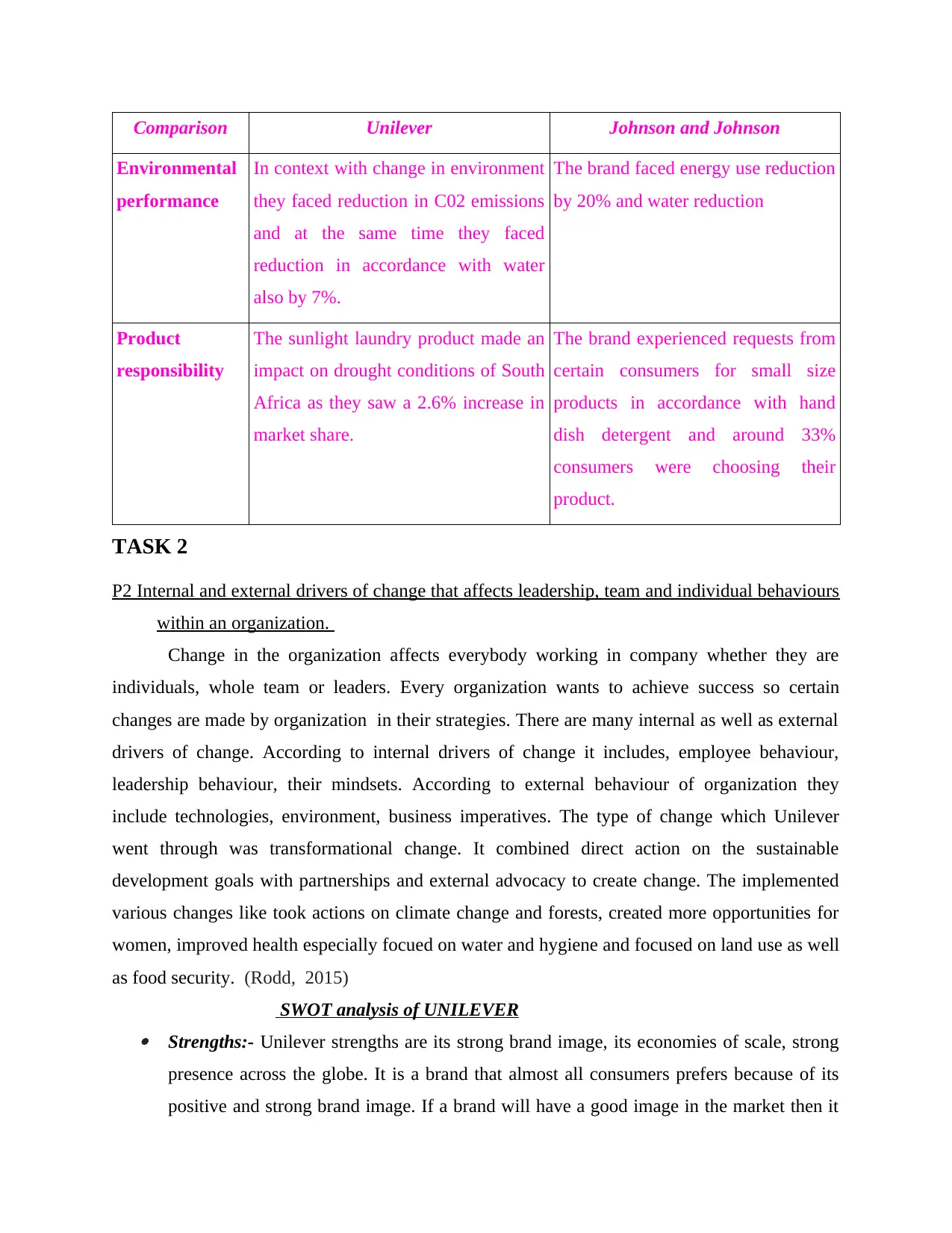
Comparison Unilever Johnson and Johnson
Environmental
performance
In context with change in environment
they faced reduction in C02 emissions
and at the same time they faced
reduction in accordance with water
also by 7%.
The brand faced energy use reduction
by 20% and water reduction
Product
responsibility
The sunlight laundry product made an
impact on drought conditions of South
Africa as they saw a 2.6% increase in
market share.
The brand experienced requests from
certain consumers for small size
products in accordance with hand
dish detergent and around 33%
consumers were choosing their
product.
TASK 2
P2 Internal and external drivers of change that affects leadership, team and individual behaviours
within an organization.
Change in the organization affects everybody working in company whether they are
individuals, whole team or leaders. Every organization wants to achieve success so certain
changes are made by organization in their strategies. There are many internal as well as external
drivers of change. According to internal drivers of change it includes, employee behaviour,
leadership behaviour, their mindsets. According to external behaviour of organization they
include technologies, environment, business imperatives. The type of change which Unilever
went through was transformational change. It combined direct action on the sustainable
development goals with partnerships and external advocacy to create change. The implemented
various changes like took actions on climate change and forests, created more opportunities for
women, improved health especially focued on water and hygiene and focused on land use as well
as food security. (Rodd, 2015)
SWOT analysis of UNILEVER Strengths:- Unilever strengths are its strong brand image, its economies of scale, strong
presence across the globe. It is a brand that almost all consumers prefers because of its
positive and strong brand image. If a brand will have a good image in the market then it
Environmental
performance
In context with change in environment
they faced reduction in C02 emissions
and at the same time they faced
reduction in accordance with water
also by 7%.
The brand faced energy use reduction
by 20% and water reduction
Product
responsibility
The sunlight laundry product made an
impact on drought conditions of South
Africa as they saw a 2.6% increase in
market share.
The brand experienced requests from
certain consumers for small size
products in accordance with hand
dish detergent and around 33%
consumers were choosing their
product.
TASK 2
P2 Internal and external drivers of change that affects leadership, team and individual behaviours
within an organization.
Change in the organization affects everybody working in company whether they are
individuals, whole team or leaders. Every organization wants to achieve success so certain
changes are made by organization in their strategies. There are many internal as well as external
drivers of change. According to internal drivers of change it includes, employee behaviour,
leadership behaviour, their mindsets. According to external behaviour of organization they
include technologies, environment, business imperatives. The type of change which Unilever
went through was transformational change. It combined direct action on the sustainable
development goals with partnerships and external advocacy to create change. The implemented
various changes like took actions on climate change and forests, created more opportunities for
women, improved health especially focued on water and hygiene and focused on land use as well
as food security. (Rodd, 2015)
SWOT analysis of UNILEVER Strengths:- Unilever strengths are its strong brand image, its economies of scale, strong
presence across the globe. It is a brand that almost all consumers prefers because of its
positive and strong brand image. If a brand will have a good image in the market then it
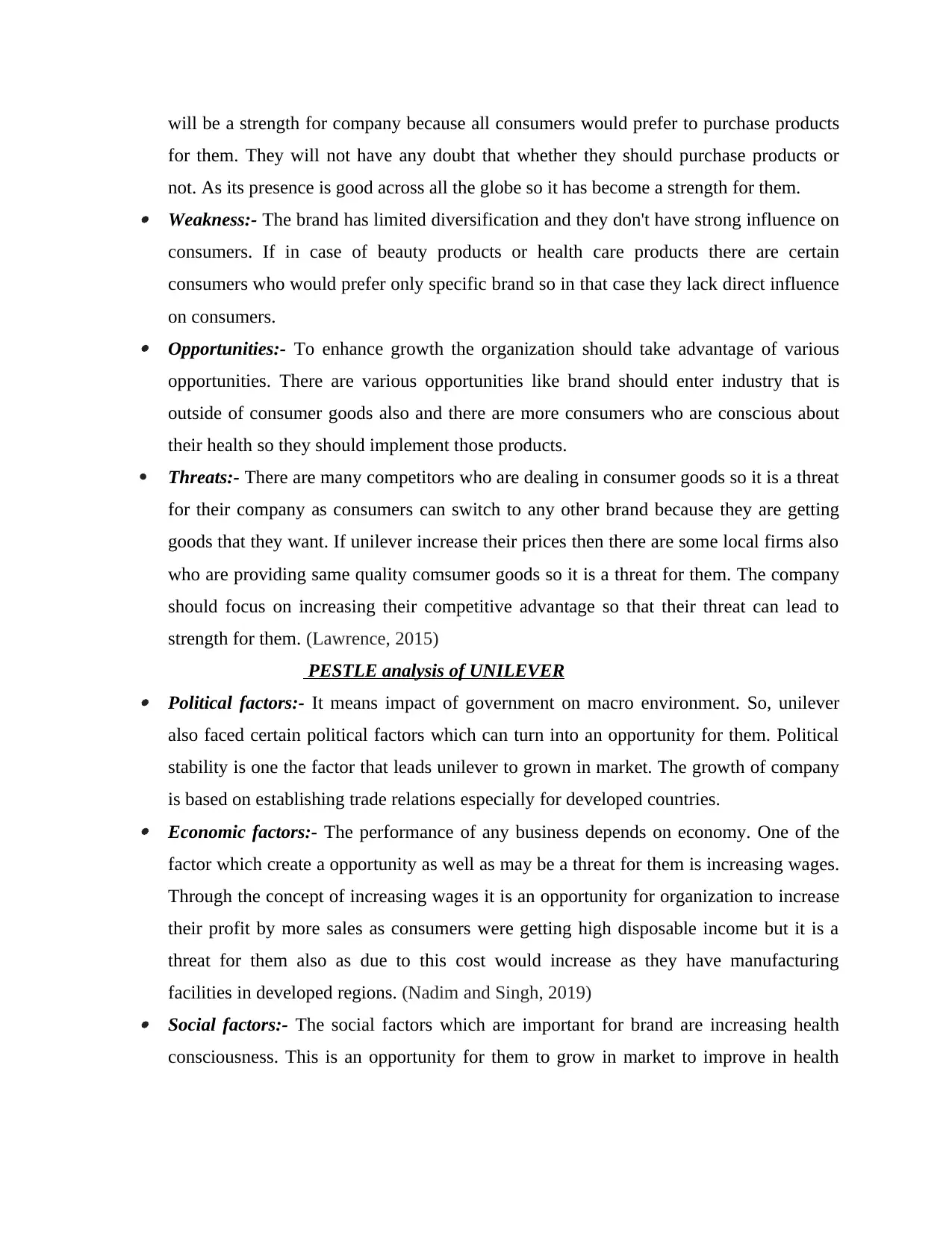
will be a strength for company because all consumers would prefer to purchase products
for them. They will not have any doubt that whether they should purchase products or
not. As its presence is good across all the globe so it has become a strength for them. Weakness:- The brand has limited diversification and they don't have strong influence on
consumers. If in case of beauty products or health care products there are certain
consumers who would prefer only specific brand so in that case they lack direct influence
on consumers. Opportunities:- To enhance growth the organization should take advantage of various
opportunities. There are various opportunities like brand should enter industry that is
outside of consumer goods also and there are more consumers who are conscious about
their health so they should implement those products.
Threats:- There are many competitors who are dealing in consumer goods so it is a threat
for their company as consumers can switch to any other brand because they are getting
goods that they want. If unilever increase their prices then there are some local firms also
who are providing same quality comsumer goods so it is a threat for them. The company
should focus on increasing their competitive advantage so that their threat can lead to
strength for them. (Lawrence, 2015)
PESTLE analysis of UNILEVER Political factors:- It means impact of government on macro environment. So, unilever
also faced certain political factors which can turn into an opportunity for them. Political
stability is one the factor that leads unilever to grown in market. The growth of company
is based on establishing trade relations especially for developed countries. Economic factors:- The performance of any business depends on economy. One of the
factor which create a opportunity as well as may be a threat for them is increasing wages.
Through the concept of increasing wages it is an opportunity for organization to increase
their profit by more sales as consumers were getting high disposable income but it is a
threat for them also as due to this cost would increase as they have manufacturing
facilities in developed regions. (Nadim and Singh, 2019) Social factors:- The social factors which are important for brand are increasing health
consciousness. This is an opportunity for them to grow in market to improve in health
for them. They will not have any doubt that whether they should purchase products or
not. As its presence is good across all the globe so it has become a strength for them. Weakness:- The brand has limited diversification and they don't have strong influence on
consumers. If in case of beauty products or health care products there are certain
consumers who would prefer only specific brand so in that case they lack direct influence
on consumers. Opportunities:- To enhance growth the organization should take advantage of various
opportunities. There are various opportunities like brand should enter industry that is
outside of consumer goods also and there are more consumers who are conscious about
their health so they should implement those products.
Threats:- There are many competitors who are dealing in consumer goods so it is a threat
for their company as consumers can switch to any other brand because they are getting
goods that they want. If unilever increase their prices then there are some local firms also
who are providing same quality comsumer goods so it is a threat for them. The company
should focus on increasing their competitive advantage so that their threat can lead to
strength for them. (Lawrence, 2015)
PESTLE analysis of UNILEVER Political factors:- It means impact of government on macro environment. So, unilever
also faced certain political factors which can turn into an opportunity for them. Political
stability is one the factor that leads unilever to grown in market. The growth of company
is based on establishing trade relations especially for developed countries. Economic factors:- The performance of any business depends on economy. One of the
factor which create a opportunity as well as may be a threat for them is increasing wages.
Through the concept of increasing wages it is an opportunity for organization to increase
their profit by more sales as consumers were getting high disposable income but it is a
threat for them also as due to this cost would increase as they have manufacturing
facilities in developed regions. (Nadim and Singh, 2019) Social factors:- The social factors which are important for brand are increasing health
consciousness. This is an opportunity for them to grow in market to improve in health
⊘ This is a preview!⊘
Do you want full access?
Subscribe today to unlock all pages.

Trusted by 1+ million students worldwide
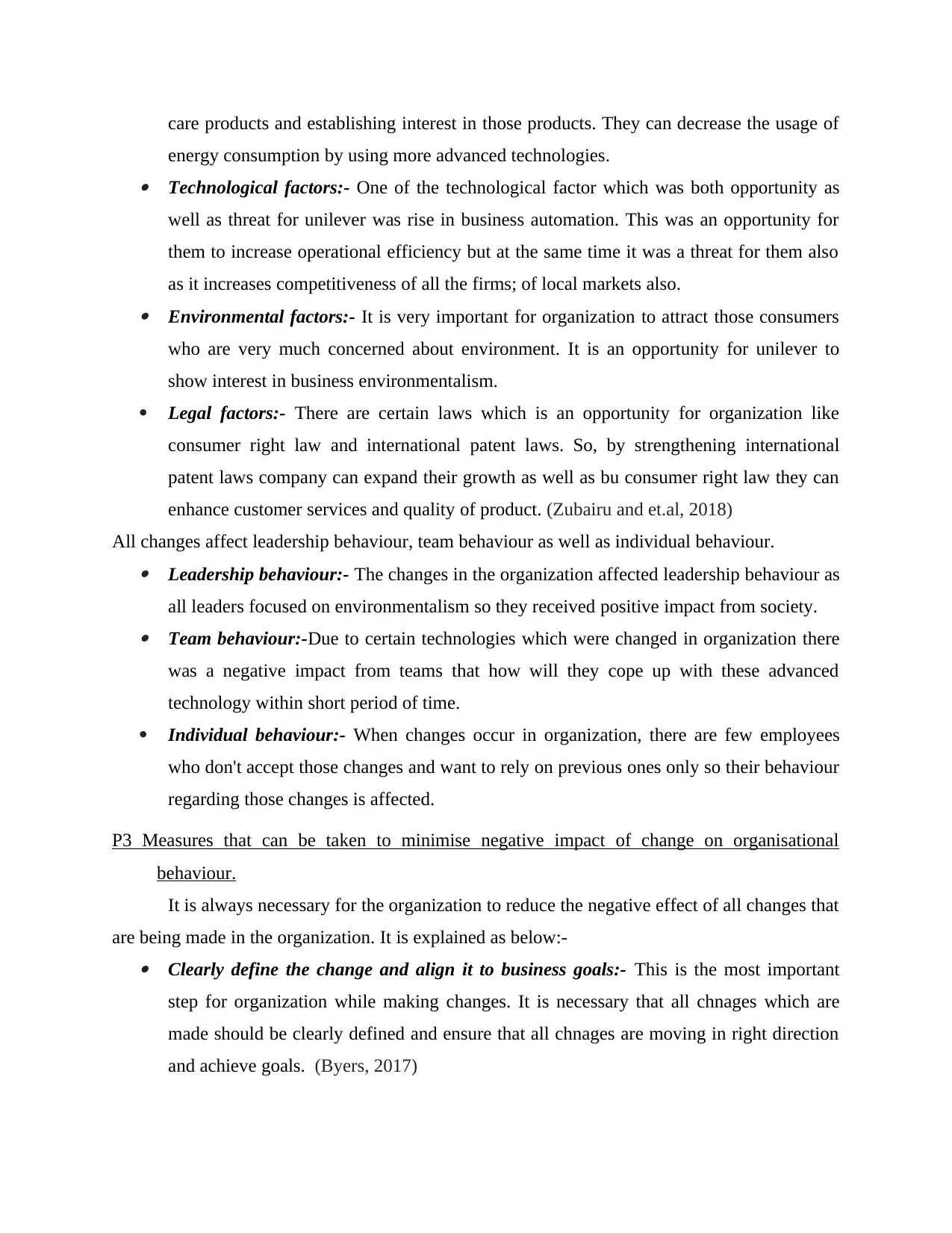
care products and establishing interest in those products. They can decrease the usage of
energy consumption by using more advanced technologies. Technological factors:- One of the technological factor which was both opportunity as
well as threat for unilever was rise in business automation. This was an opportunity for
them to increase operational efficiency but at the same time it was a threat for them also
as it increases competitiveness of all the firms; of local markets also. Environmental factors:- It is very important for organization to attract those consumers
who are very much concerned about environment. It is an opportunity for unilever to
show interest in business environmentalism.
Legal factors:- There are certain laws which is an opportunity for organization like
consumer right law and international patent laws. So, by strengthening international
patent laws company can expand their growth as well as bu consumer right law they can
enhance customer services and quality of product. (Zubairu and et.al, 2018)
All changes affect leadership behaviour, team behaviour as well as individual behaviour. Leadership behaviour:- The changes in the organization affected leadership behaviour as
all leaders focused on environmentalism so they received positive impact from society. Team behaviour:-Due to certain technologies which were changed in organization there
was a negative impact from teams that how will they cope up with these advanced
technology within short period of time.
Individual behaviour:- When changes occur in organization, there are few employees
who don't accept those changes and want to rely on previous ones only so their behaviour
regarding those changes is affected.
P3 Measures that can be taken to minimise negative impact of change on organisational
behaviour.
It is always necessary for the organization to reduce the negative effect of all changes that
are being made in the organization. It is explained as below:- Clearly define the change and align it to business goals:- This is the most important
step for organization while making changes. It is necessary that all chnages which are
made should be clearly defined and ensure that all chnages are moving in right direction
and achieve goals. (Byers, 2017)
energy consumption by using more advanced technologies. Technological factors:- One of the technological factor which was both opportunity as
well as threat for unilever was rise in business automation. This was an opportunity for
them to increase operational efficiency but at the same time it was a threat for them also
as it increases competitiveness of all the firms; of local markets also. Environmental factors:- It is very important for organization to attract those consumers
who are very much concerned about environment. It is an opportunity for unilever to
show interest in business environmentalism.
Legal factors:- There are certain laws which is an opportunity for organization like
consumer right law and international patent laws. So, by strengthening international
patent laws company can expand their growth as well as bu consumer right law they can
enhance customer services and quality of product. (Zubairu and et.al, 2018)
All changes affect leadership behaviour, team behaviour as well as individual behaviour. Leadership behaviour:- The changes in the organization affected leadership behaviour as
all leaders focused on environmentalism so they received positive impact from society. Team behaviour:-Due to certain technologies which were changed in organization there
was a negative impact from teams that how will they cope up with these advanced
technology within short period of time.
Individual behaviour:- When changes occur in organization, there are few employees
who don't accept those changes and want to rely on previous ones only so their behaviour
regarding those changes is affected.
P3 Measures that can be taken to minimise negative impact of change on organisational
behaviour.
It is always necessary for the organization to reduce the negative effect of all changes that
are being made in the organization. It is explained as below:- Clearly define the change and align it to business goals:- This is the most important
step for organization while making changes. It is necessary that all chnages which are
made should be clearly defined and ensure that all chnages are moving in right direction
and achieve goals. (Byers, 2017)
Paraphrase This Document
Need a fresh take? Get an instant paraphrase of this document with our AI Paraphraser
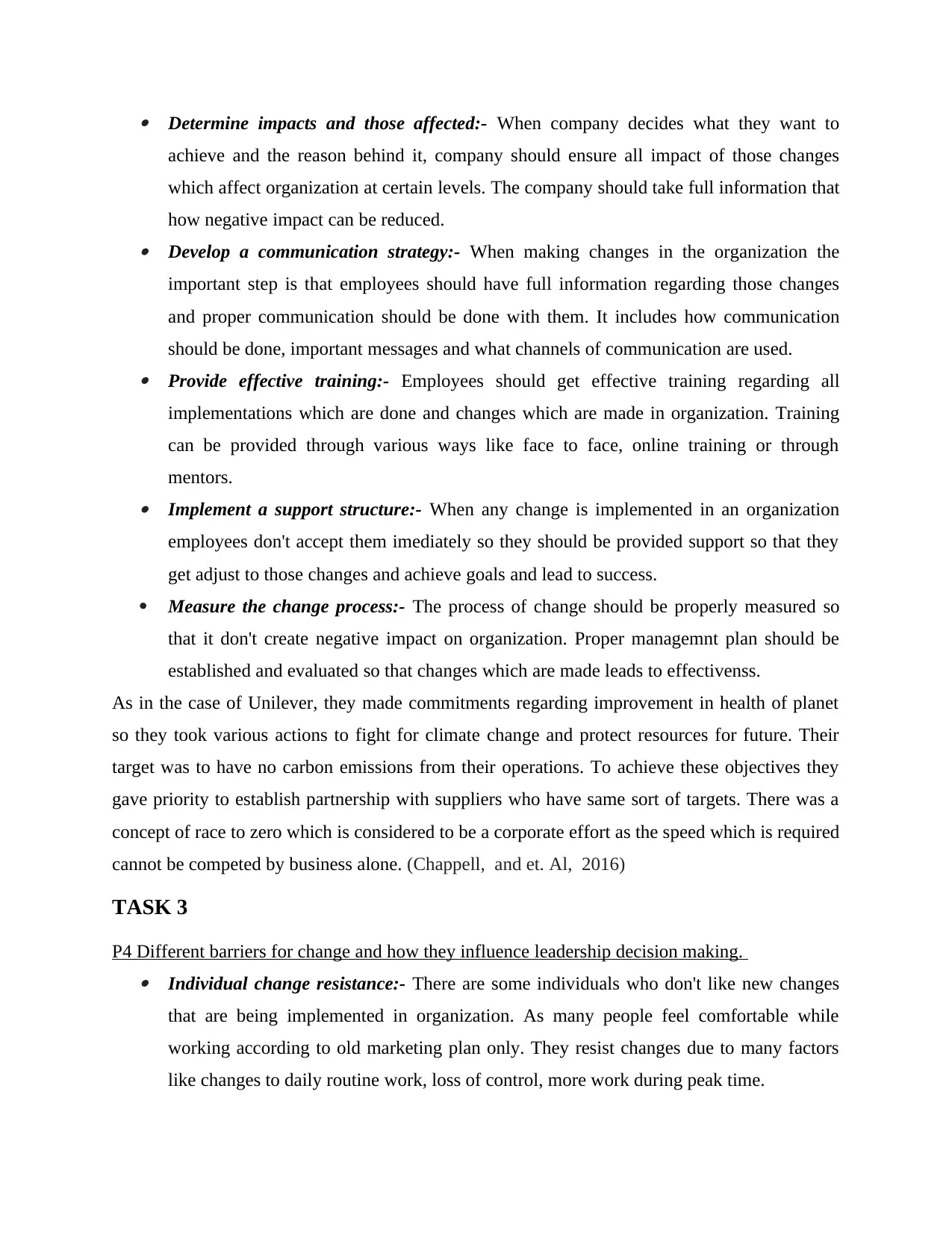
Determine impacts and those affected:- When company decides what they want to
achieve and the reason behind it, company should ensure all impact of those changes
which affect organization at certain levels. The company should take full information that
how negative impact can be reduced. Develop a communication strategy:- When making changes in the organization the
important step is that employees should have full information regarding those changes
and proper communication should be done with them. It includes how communication
should be done, important messages and what channels of communication are used. Provide effective training:- Employees should get effective training regarding all
implementations which are done and changes which are made in organization. Training
can be provided through various ways like face to face, online training or through
mentors. Implement a support structure:- When any change is implemented in an organization
employees don't accept them imediately so they should be provided support so that they
get adjust to those changes and achieve goals and lead to success.
Measure the change process:- The process of change should be properly measured so
that it don't create negative impact on organization. Proper managemnt plan should be
established and evaluated so that changes which are made leads to effectivenss.
As in the case of Unilever, they made commitments regarding improvement in health of planet
so they took various actions to fight for climate change and protect resources for future. Their
target was to have no carbon emissions from their operations. To achieve these objectives they
gave priority to establish partnership with suppliers who have same sort of targets. There was a
concept of race to zero which is considered to be a corporate effort as the speed which is required
cannot be competed by business alone. (Chappell, and et. Al, 2016)
TASK 3
P4 Different barriers for change and how they influence leadership decision making. Individual change resistance:- There are some individuals who don't like new changes
that are being implemented in organization. As many people feel comfortable while
working according to old marketing plan only. They resist changes due to many factors
like changes to daily routine work, loss of control, more work during peak time.
achieve and the reason behind it, company should ensure all impact of those changes
which affect organization at certain levels. The company should take full information that
how negative impact can be reduced. Develop a communication strategy:- When making changes in the organization the
important step is that employees should have full information regarding those changes
and proper communication should be done with them. It includes how communication
should be done, important messages and what channels of communication are used. Provide effective training:- Employees should get effective training regarding all
implementations which are done and changes which are made in organization. Training
can be provided through various ways like face to face, online training or through
mentors. Implement a support structure:- When any change is implemented in an organization
employees don't accept them imediately so they should be provided support so that they
get adjust to those changes and achieve goals and lead to success.
Measure the change process:- The process of change should be properly measured so
that it don't create negative impact on organization. Proper managemnt plan should be
established and evaluated so that changes which are made leads to effectivenss.
As in the case of Unilever, they made commitments regarding improvement in health of planet
so they took various actions to fight for climate change and protect resources for future. Their
target was to have no carbon emissions from their operations. To achieve these objectives they
gave priority to establish partnership with suppliers who have same sort of targets. There was a
concept of race to zero which is considered to be a corporate effort as the speed which is required
cannot be competed by business alone. (Chappell, and et. Al, 2016)
TASK 3
P4 Different barriers for change and how they influence leadership decision making. Individual change resistance:- There are some individuals who don't like new changes
that are being implemented in organization. As many people feel comfortable while
working according to old marketing plan only. They resist changes due to many factors
like changes to daily routine work, loss of control, more work during peak time.
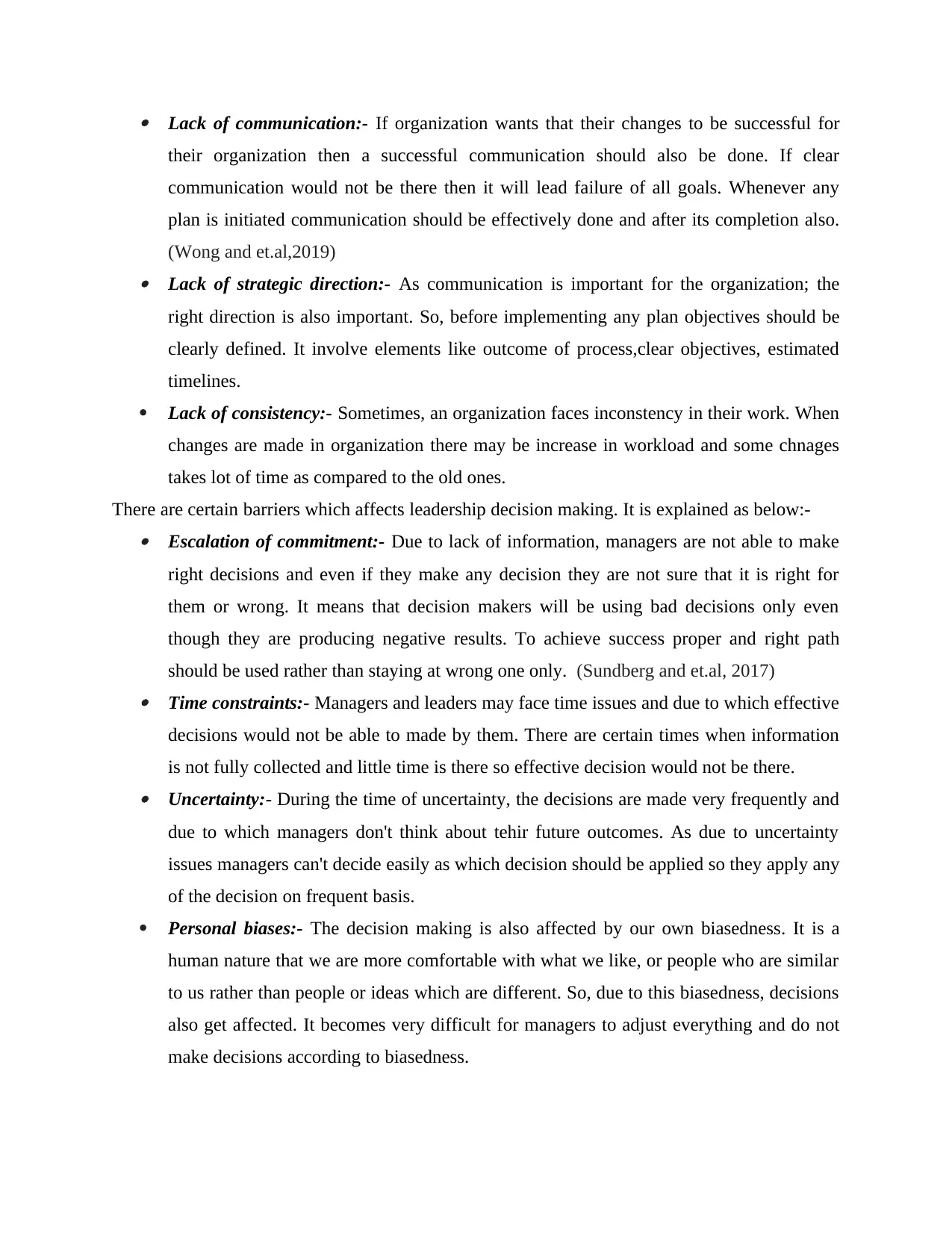
Lack of communication:- If organization wants that their changes to be successful for
their organization then a successful communication should also be done. If clear
communication would not be there then it will lead failure of all goals. Whenever any
plan is initiated communication should be effectively done and after its completion also.
(Wong and et.al,2019) Lack of strategic direction:- As communication is important for the organization; the
right direction is also important. So, before implementing any plan objectives should be
clearly defined. It involve elements like outcome of process,clear objectives, estimated
timelines.
Lack of consistency:- Sometimes, an organization faces inconstency in their work. When
changes are made in organization there may be increase in workload and some chnages
takes lot of time as compared to the old ones.
There are certain barriers which affects leadership decision making. It is explained as below:- Escalation of commitment:- Due to lack of information, managers are not able to make
right decisions and even if they make any decision they are not sure that it is right for
them or wrong. It means that decision makers will be using bad decisions only even
though they are producing negative results. To achieve success proper and right path
should be used rather than staying at wrong one only. (Sundberg and et.al, 2017) Time constraints:- Managers and leaders may face time issues and due to which effective
decisions would not be able to made by them. There are certain times when information
is not fully collected and little time is there so effective decision would not be there. Uncertainty:- During the time of uncertainty, the decisions are made very frequently and
due to which managers don't think about tehir future outcomes. As due to uncertainty
issues managers can't decide easily as which decision should be applied so they apply any
of the decision on frequent basis.
Personal biases:- The decision making is also affected by our own biasedness. It is a
human nature that we are more comfortable with what we like, or people who are similar
to us rather than people or ideas which are different. So, due to this biasedness, decisions
also get affected. It becomes very difficult for managers to adjust everything and do not
make decisions according to biasedness.
their organization then a successful communication should also be done. If clear
communication would not be there then it will lead failure of all goals. Whenever any
plan is initiated communication should be effectively done and after its completion also.
(Wong and et.al,2019) Lack of strategic direction:- As communication is important for the organization; the
right direction is also important. So, before implementing any plan objectives should be
clearly defined. It involve elements like outcome of process,clear objectives, estimated
timelines.
Lack of consistency:- Sometimes, an organization faces inconstency in their work. When
changes are made in organization there may be increase in workload and some chnages
takes lot of time as compared to the old ones.
There are certain barriers which affects leadership decision making. It is explained as below:- Escalation of commitment:- Due to lack of information, managers are not able to make
right decisions and even if they make any decision they are not sure that it is right for
them or wrong. It means that decision makers will be using bad decisions only even
though they are producing negative results. To achieve success proper and right path
should be used rather than staying at wrong one only. (Sundberg and et.al, 2017) Time constraints:- Managers and leaders may face time issues and due to which effective
decisions would not be able to made by them. There are certain times when information
is not fully collected and little time is there so effective decision would not be there. Uncertainty:- During the time of uncertainty, the decisions are made very frequently and
due to which managers don't think about tehir future outcomes. As due to uncertainty
issues managers can't decide easily as which decision should be applied so they apply any
of the decision on frequent basis.
Personal biases:- The decision making is also affected by our own biasedness. It is a
human nature that we are more comfortable with what we like, or people who are similar
to us rather than people or ideas which are different. So, due to this biasedness, decisions
also get affected. It becomes very difficult for managers to adjust everything and do not
make decisions according to biasedness.
⊘ This is a preview!⊘
Do you want full access?
Subscribe today to unlock all pages.

Trusted by 1+ million students worldwide
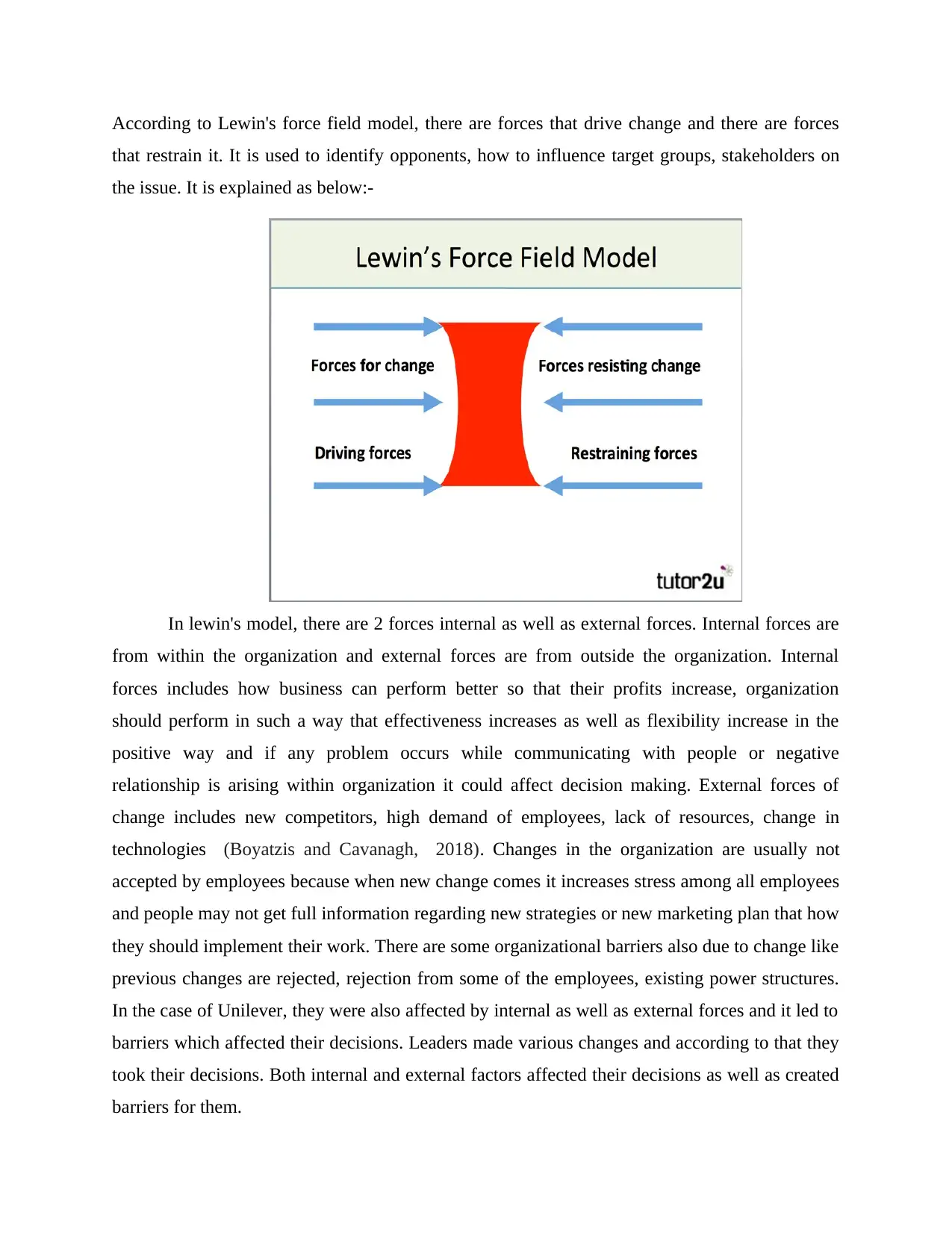
According to Lewin's force field model, there are forces that drive change and there are forces
that restrain it. It is used to identify opponents, how to influence target groups, stakeholders on
the issue. It is explained as below:-
In lewin's model, there are 2 forces internal as well as external forces. Internal forces are
from within the organization and external forces are from outside the organization. Internal
forces includes how business can perform better so that their profits increase, organization
should perform in such a way that effectiveness increases as well as flexibility increase in the
positive way and if any problem occurs while communicating with people or negative
relationship is arising within organization it could affect decision making. External forces of
change includes new competitors, high demand of employees, lack of resources, change in
technologies (Boyatzis and Cavanagh, 2018). Changes in the organization are usually not
accepted by employees because when new change comes it increases stress among all employees
and people may not get full information regarding new strategies or new marketing plan that how
they should implement their work. There are some organizational barriers also due to change like
previous changes are rejected, rejection from some of the employees, existing power structures.
In the case of Unilever, they were also affected by internal as well as external forces and it led to
barriers which affected their decisions. Leaders made various changes and according to that they
took their decisions. Both internal and external factors affected their decisions as well as created
barriers for them.
that restrain it. It is used to identify opponents, how to influence target groups, stakeholders on
the issue. It is explained as below:-
In lewin's model, there are 2 forces internal as well as external forces. Internal forces are
from within the organization and external forces are from outside the organization. Internal
forces includes how business can perform better so that their profits increase, organization
should perform in such a way that effectiveness increases as well as flexibility increase in the
positive way and if any problem occurs while communicating with people or negative
relationship is arising within organization it could affect decision making. External forces of
change includes new competitors, high demand of employees, lack of resources, change in
technologies (Boyatzis and Cavanagh, 2018). Changes in the organization are usually not
accepted by employees because when new change comes it increases stress among all employees
and people may not get full information regarding new strategies or new marketing plan that how
they should implement their work. There are some organizational barriers also due to change like
previous changes are rejected, rejection from some of the employees, existing power structures.
In the case of Unilever, they were also affected by internal as well as external forces and it led to
barriers which affected their decisions. Leaders made various changes and according to that they
took their decisions. Both internal and external factors affected their decisions as well as created
barriers for them.
Paraphrase This Document
Need a fresh take? Get an instant paraphrase of this document with our AI Paraphraser
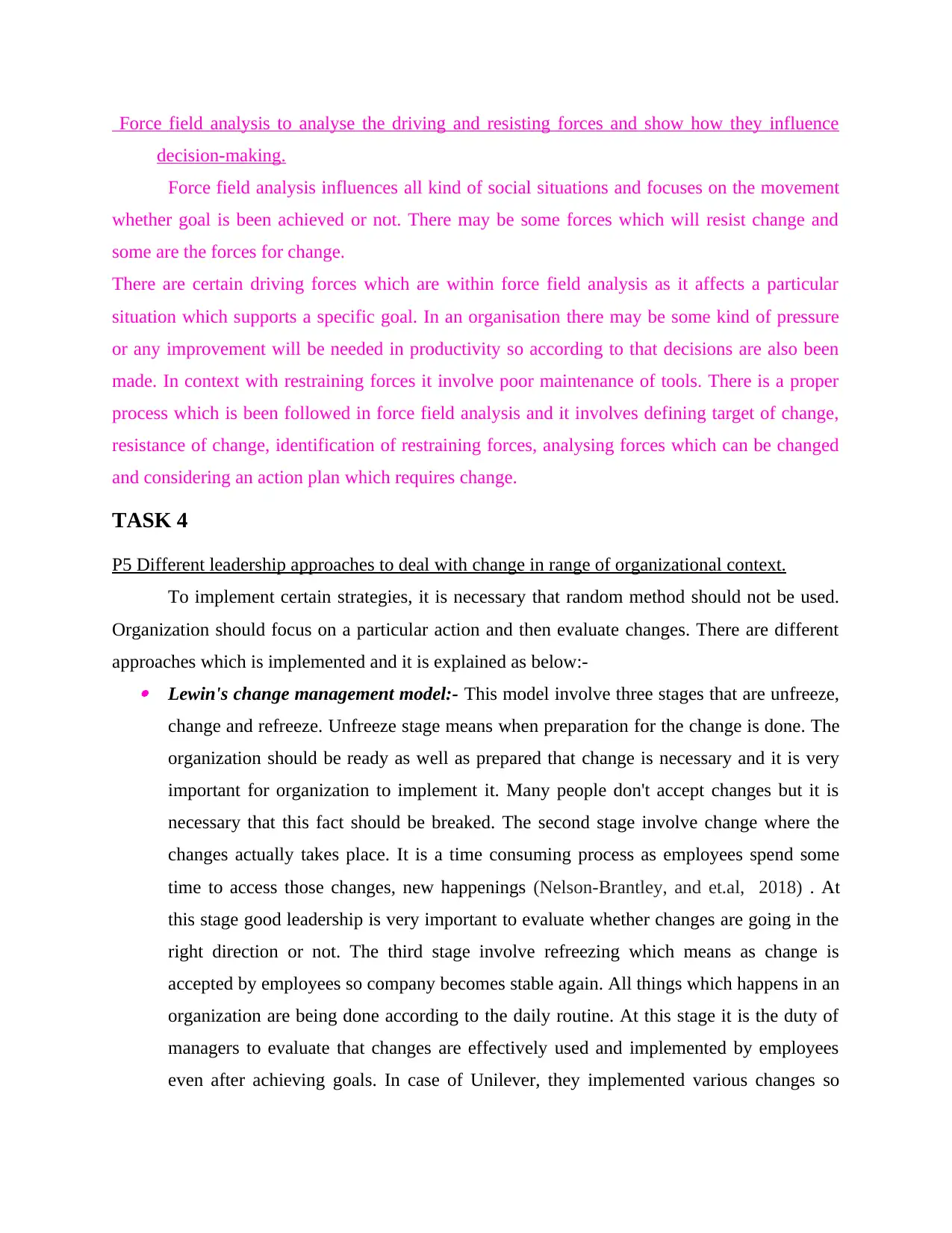
Force field analysis to analyse the driving and resisting forces and show how they influence
decision-making.
Force field analysis influences all kind of social situations and focuses on the movement
whether goal is been achieved or not. There may be some forces which will resist change and
some are the forces for change.
There are certain driving forces which are within force field analysis as it affects a particular
situation which supports a specific goal. In an organisation there may be some kind of pressure
or any improvement will be needed in productivity so according to that decisions are also been
made. In context with restraining forces it involve poor maintenance of tools. There is a proper
process which is been followed in force field analysis and it involves defining target of change,
resistance of change, identification of restraining forces, analysing forces which can be changed
and considering an action plan which requires change.
TASK 4
P5 Different leadership approaches to deal with change in range of organizational context.
To implement certain strategies, it is necessary that random method should not be used.
Organization should focus on a particular action and then evaluate changes. There are different
approaches which is implemented and it is explained as below:- Lewin's change management model:- This model involve three stages that are unfreeze,
change and refreeze. Unfreeze stage means when preparation for the change is done. The
organization should be ready as well as prepared that change is necessary and it is very
important for organization to implement it. Many people don't accept changes but it is
necessary that this fact should be breaked. The second stage involve change where the
changes actually takes place. It is a time consuming process as employees spend some
time to access those changes, new happenings (Nelson-Brantley, and et.al, 2018) . At
this stage good leadership is very important to evaluate whether changes are going in the
right direction or not. The third stage involve refreezing which means as change is
accepted by employees so company becomes stable again. All things which happens in an
organization are being done according to the daily routine. At this stage it is the duty of
managers to evaluate that changes are effectively used and implemented by employees
even after achieving goals. In case of Unilever, they implemented various changes so
decision-making.
Force field analysis influences all kind of social situations and focuses on the movement
whether goal is been achieved or not. There may be some forces which will resist change and
some are the forces for change.
There are certain driving forces which are within force field analysis as it affects a particular
situation which supports a specific goal. In an organisation there may be some kind of pressure
or any improvement will be needed in productivity so according to that decisions are also been
made. In context with restraining forces it involve poor maintenance of tools. There is a proper
process which is been followed in force field analysis and it involves defining target of change,
resistance of change, identification of restraining forces, analysing forces which can be changed
and considering an action plan which requires change.
TASK 4
P5 Different leadership approaches to deal with change in range of organizational context.
To implement certain strategies, it is necessary that random method should not be used.
Organization should focus on a particular action and then evaluate changes. There are different
approaches which is implemented and it is explained as below:- Lewin's change management model:- This model involve three stages that are unfreeze,
change and refreeze. Unfreeze stage means when preparation for the change is done. The
organization should be ready as well as prepared that change is necessary and it is very
important for organization to implement it. Many people don't accept changes but it is
necessary that this fact should be breaked. The second stage involve change where the
changes actually takes place. It is a time consuming process as employees spend some
time to access those changes, new happenings (Nelson-Brantley, and et.al, 2018) . At
this stage good leadership is very important to evaluate whether changes are going in the
right direction or not. The third stage involve refreezing which means as change is
accepted by employees so company becomes stable again. All things which happens in an
organization are being done according to the daily routine. At this stage it is the duty of
managers to evaluate that changes are effectively used and implemented by employees
even after achieving goals. In case of Unilever, they implemented various changes so
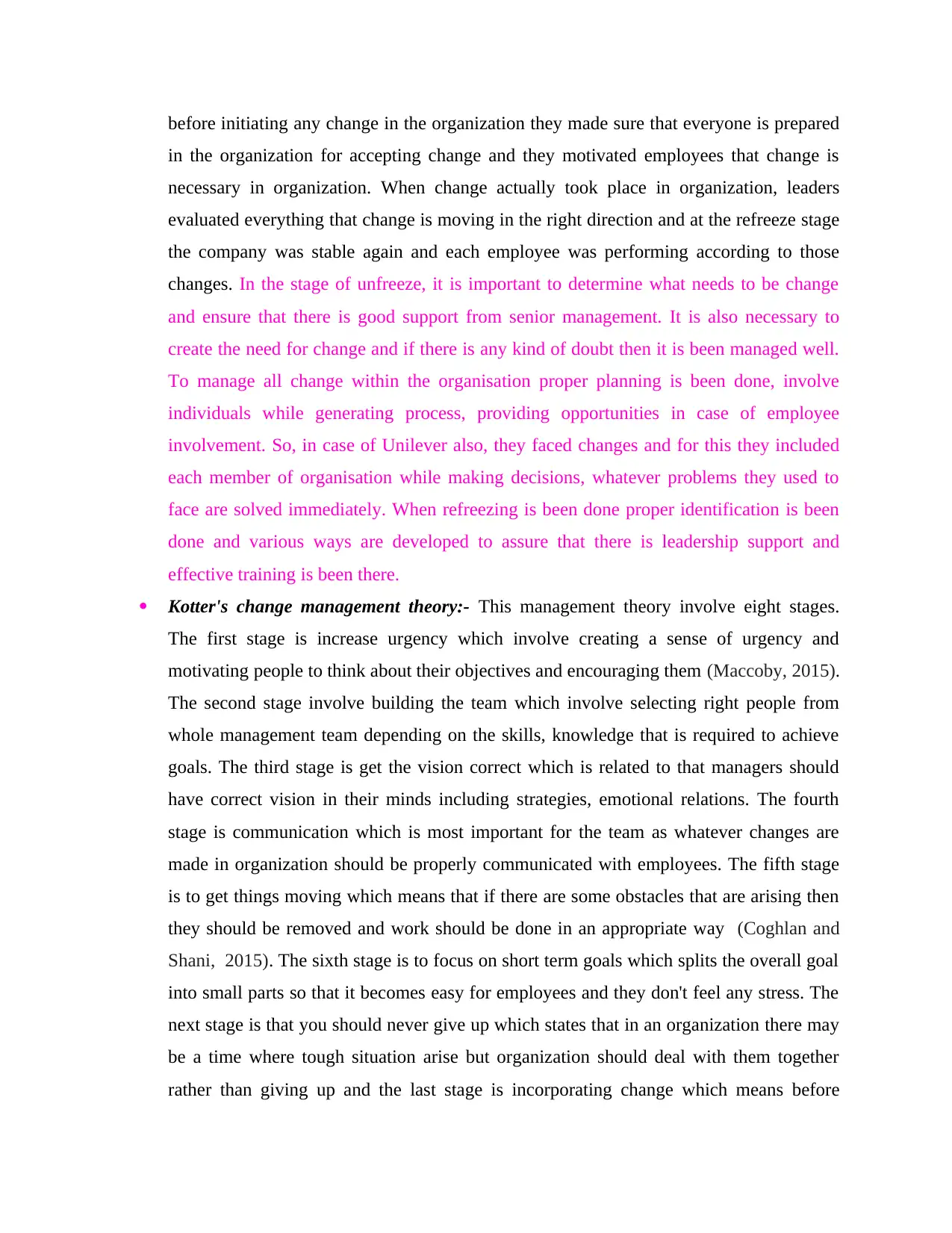
before initiating any change in the organization they made sure that everyone is prepared
in the organization for accepting change and they motivated employees that change is
necessary in organization. When change actually took place in organization, leaders
evaluated everything that change is moving in the right direction and at the refreeze stage
the company was stable again and each employee was performing according to those
changes. In the stage of unfreeze, it is important to determine what needs to be change
and ensure that there is good support from senior management. It is also necessary to
create the need for change and if there is any kind of doubt then it is been managed well.
To manage all change within the organisation proper planning is been done, involve
individuals while generating process, providing opportunities in case of employee
involvement. So, in case of Unilever also, they faced changes and for this they included
each member of organisation while making decisions, whatever problems they used to
face are solved immediately. When refreezing is been done proper identification is been
done and various ways are developed to assure that there is leadership support and
effective training is been there.
Kotter's change management theory:- This management theory involve eight stages.
The first stage is increase urgency which involve creating a sense of urgency and
motivating people to think about their objectives and encouraging them (Maccoby, 2015).
The second stage involve building the team which involve selecting right people from
whole management team depending on the skills, knowledge that is required to achieve
goals. The third stage is get the vision correct which is related to that managers should
have correct vision in their minds including strategies, emotional relations. The fourth
stage is communication which is most important for the team as whatever changes are
made in organization should be properly communicated with employees. The fifth stage
is to get things moving which means that if there are some obstacles that are arising then
they should be removed and work should be done in an appropriate way (Coghlan and
Shani, 2015). The sixth stage is to focus on short term goals which splits the overall goal
into small parts so that it becomes easy for employees and they don't feel any stress. The
next stage is that you should never give up which states that in an organization there may
be a time where tough situation arise but organization should deal with them together
rather than giving up and the last stage is incorporating change which means before
in the organization for accepting change and they motivated employees that change is
necessary in organization. When change actually took place in organization, leaders
evaluated everything that change is moving in the right direction and at the refreeze stage
the company was stable again and each employee was performing according to those
changes. In the stage of unfreeze, it is important to determine what needs to be change
and ensure that there is good support from senior management. It is also necessary to
create the need for change and if there is any kind of doubt then it is been managed well.
To manage all change within the organisation proper planning is been done, involve
individuals while generating process, providing opportunities in case of employee
involvement. So, in case of Unilever also, they faced changes and for this they included
each member of organisation while making decisions, whatever problems they used to
face are solved immediately. When refreezing is been done proper identification is been
done and various ways are developed to assure that there is leadership support and
effective training is been there.
Kotter's change management theory:- This management theory involve eight stages.
The first stage is increase urgency which involve creating a sense of urgency and
motivating people to think about their objectives and encouraging them (Maccoby, 2015).
The second stage involve building the team which involve selecting right people from
whole management team depending on the skills, knowledge that is required to achieve
goals. The third stage is get the vision correct which is related to that managers should
have correct vision in their minds including strategies, emotional relations. The fourth
stage is communication which is most important for the team as whatever changes are
made in organization should be properly communicated with employees. The fifth stage
is to get things moving which means that if there are some obstacles that are arising then
they should be removed and work should be done in an appropriate way (Coghlan and
Shani, 2015). The sixth stage is to focus on short term goals which splits the overall goal
into small parts so that it becomes easy for employees and they don't feel any stress. The
next stage is that you should never give up which states that in an organization there may
be a time where tough situation arise but organization should deal with them together
rather than giving up and the last stage is incorporating change which means before
⊘ This is a preview!⊘
Do you want full access?
Subscribe today to unlock all pages.

Trusted by 1+ million students worldwide
1 out of 17
Related Documents
Your All-in-One AI-Powered Toolkit for Academic Success.
+13062052269
info@desklib.com
Available 24*7 on WhatsApp / Email
![[object Object]](/_next/static/media/star-bottom.7253800d.svg)
Unlock your academic potential
Copyright © 2020–2025 A2Z Services. All Rights Reserved. Developed and managed by ZUCOL.





